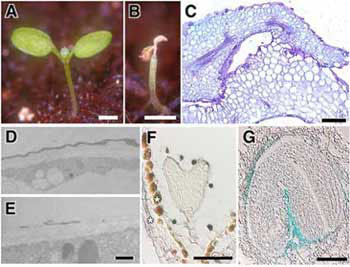| III. DEVELOPMENT
OF PLANT EPIDERMIS
AND ITS FUNCTION FOR PLANT MORPHOGENESIS Recent references Tanaka et al., Development (2001) Tanaka et al., Plant & Cell Physiol. (2002) The surfaces of land plants are
covered with a cuticle that is essential for retention of water.
Epidermal surfaces of Arabidopsis thaliana embryos and juvenile
plants that were homozygous for abnormal leaf shape1 (ale1)
mutations were defective, resulting in excessive water loss and organ fusion
in young plants. In ale1 embryos, the cuticle was rudimentary
and remnants of the endosperm remained attached to developing embryos.
Juvenile plants had a similar abnormal cuticle. The ALE1 gene
was isolated using a transposon-tagged allele ale1-1. The
predicted ALE1 amino acid sequence was homologous to those of subtilisin-like
serine proteases. The ALE1 gene was expressed within certain
endosperm cells adjacent to the embryo and within the young embryo.
Expression was not detected after germination. Our results suggest
that the putative protease ALE1 affects the formation of cuticle on embryos
and juvenile plants and that an appropriate cuticle is required for separation
of the endosperm from the embryo and for prevention of organ fusion.
|
